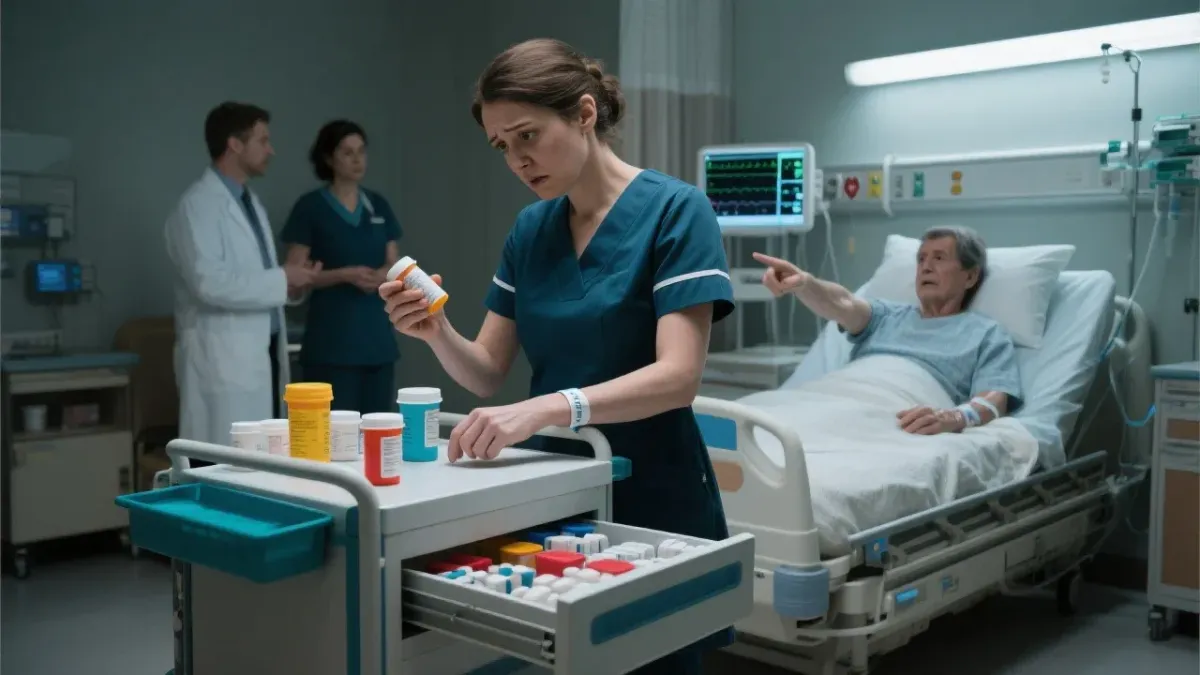Nursing Errors That Caused Patient Harm
Date published: June 18, 2025

1. Medication Error Leading to Patient Death in Tennessee
A notable case involved a nurse who, due to an override feature in an automatic dispensing cabinet, selected and administered the wrong drug a paralyzing agent instead of midazolam hydrochloride to an elderly patient prior to a PET scan. This error resulted in the patient experiencing cardiac arrest and subsequent death after resuscitation efforts failed. This case illustrates how system design flaws and human error can combine to cause severe patient harm and underscores the importance of just culture approaches that support error prevention and non-punitive responses to mistakes.
2. Medication Errors as a Leading Cause of Patient Harm
Medication errors are among the most common and serious nursing errors causing patient harm. Studies show that nurses contribute significantly to medication errors, with prevalence rates between 16% and 27% in some reviews. Organizational barriers such as lack of proper reporting systems, unclear definitions of medication errors, and fear of punitive actions hinder nurses from reporting errors, which impedes learning and prevention efforts. Creating a non-punitive environment and effective reporting systems is crucial to improving patient safety.
3. Missed Nursing Care and Its Consequences
Errors of omission, or "missed nursing care," occur when necessary nursing actions are delayed, partially completed, or omitted altogether. These errors are linked to adverse outcomes such as medication errors, infections, falls, pressure injuries, readmissions, and failure to rescue. Factors contributing to missed care include high patient-to-nurse ratios and systemic issues. Addressing these factors through better staffing, leadership, and teamwork can reduce nursing errors and improve patient outcomes.
4. Prevalence and Severity of Preventable Patient Harm
A meta-analysis of 70 studies involving over 337,000 patients found that 6% experienced preventable patient harm, with 12% of these cases being severe or fatal. Drug-related incidents accounted for the largest proportion of preventable harm, highlighting the critical role of nursing in medication safety and error prevention.
5. Ethical and Cultural Considerations in Nursing Errors
Nurses have an ethical obligation to prevent, report, and disclose errors. The literature emphasizes shaping a culture of safety where errors are openly discussed without fear of blame, enabling learning and system improvements. This cultural shift is essential for reducing nursing errors and protecting patients.
These cases and discussions collectively highlight that nursing errors causing patient harm often involve medication mistakes, system and organizational barriers to error reporting, and errors of omission. Addressing these issues requires systemic changes including improved reporting systems, supportive leadership, adequate staffing, and fostering a just culture that balances accountability with learning and support.
What are some documented cases of nursing errors causing patient harm in recent studies
The types of nursing errors most frequently leading to severe patient injuries are:
• Medication Errors: These are the most common and preventable cause of patient harm, affecting about 6.5% of acute hospital stays. Medication errors include wrong dose, wrong medication, improper timing, failure to account for allergies, and inadequate patient education. Such errors can cause severe or life-threatening harm, including allergic reactions, cardiovascular events, and death.
• Surgical Errors: Although more directly linked to surgeons, nursing errors related to surgical care (such as instrument counts, infection control, and postoperative monitoring) contribute to severe injuries. Surgical errors are a major driver of severe patient injury and death, accounting for a significant portion of malpractice claims. Intraoperative errors pose the highest risk.
• Patient Falls: Falls are the most frequent adverse events in hospitals, with over one-third resulting in injury. These injuries can delay recovery, cause complications, and increase healthcare costs. Nurses play a key role in fall prevention.
• Health Care-Associated Infections: Errors in infection control and wound care can lead to serious infections, prolonged hospital stays, and even fatal outcomes. Neglecting standard procedures such as hand hygiene and wound care is a frequent nursing error leading to harm.
• Failure to Act on Changes in Patient Condition: Nurses' failure to recognize or report deteriorating patient conditions (e.g., signs of infection or sepsis) can result in severe complications or death.
• Miscommunication Among Healthcare Staff: Poor communication during handoffs or with physicians can lead to incorrect treatments or missed critical information, increasing the risk of severe patient harm.
In summary, medication errors and surgical-related errors are the most frequent nursing errors leading to severe injuries, followed by patient falls, infections, and failures in monitoring and communication.
Visit our website https://drjuliesiemers.com/lifebeat-solutions/ and book a consultation with us. For inquiries, you can also reach out via email at [email protected].
#PatientSafety #MedicationErrors #NursingErrors #Healthcare #HarmPrevention
Nursing Errors That Caused Patient Harm
Date published: June 18, 2025

1. Medication Error Leading to Patient Death in Tennessee
A notable case involved a nurse who, due to an override feature in an automatic dispensing cabinet, selected and administered the wrong drug a paralyzing agent instead of midazolam hydrochloride to an elderly patient prior to a PET scan. This error resulted in the patient experiencing cardiac arrest and subsequent death after resuscitation efforts failed. This case illustrates how system design flaws and human error can combine to cause severe patient harm and underscores the importance of just culture approaches that support error prevention and non-punitive responses to mistakes.
2. Medication Errors as a Leading Cause of Patient Harm
Medication errors are among the most common and serious nursing errors causing patient harm. Studies show that nurses contribute significantly to medication errors, with prevalence rates between 16% and 27% in some reviews. Organizational barriers such as lack of proper reporting systems, unclear definitions of medication errors, and fear of punitive actions hinder nurses from reporting errors, which impedes learning and prevention efforts. Creating a non-punitive environment and effective reporting systems is crucial to improving patient safety.
3. Missed Nursing Care and Its Consequences
Errors of omission, or "missed nursing care," occur when necessary nursing actions are delayed, partially completed, or omitted altogether. These errors are linked to adverse outcomes such as medication errors, infections, falls, pressure injuries, readmissions, and failure to rescue. Factors contributing to missed care include high patient-to-nurse ratios and systemic issues. Addressing these factors through better staffing, leadership, and teamwork can reduce nursing errors and improve patient outcomes.
4. Prevalence and Severity of Preventable Patient Harm
A meta-analysis of 70 studies involving over 337,000 patients found that 6% experienced preventable patient harm, with 12% of these cases being severe or fatal. Drug-related incidents accounted for the largest proportion of preventable harm, highlighting the critical role of nursing in medication safety and error prevention.
5. Ethical and Cultural Considerations in Nursing Errors
Nurses have an ethical obligation to prevent, report, and disclose errors. The literature emphasizes shaping a culture of safety where errors are openly discussed without fear of blame, enabling learning and system improvements. This cultural shift is essential for reducing nursing errors and protecting patients.
These cases and discussions collectively highlight that nursing errors causing patient harm often involve medication mistakes, system and organizational barriers to error reporting, and errors of omission. Addressing these issues requires systemic changes including improved reporting systems, supportive leadership, adequate staffing, and fostering a just culture that balances accountability with learning and support.
What are some documented cases of nursing errors causing patient harm in recent studies
The types of nursing errors most frequently leading to severe patient injuries are:
• Medication Errors: These are the most common and preventable cause of patient harm, affecting about 6.5% of acute hospital stays. Medication errors include wrong dose, wrong medication, improper timing, failure to account for allergies, and inadequate patient education. Such errors can cause severe or life-threatening harm, including allergic reactions, cardiovascular events, and death.
• Surgical Errors: Although more directly linked to surgeons, nursing errors related to surgical care (such as instrument counts, infection control, and postoperative monitoring) contribute to severe injuries. Surgical errors are a major driver of severe patient injury and death, accounting for a significant portion of malpractice claims. Intraoperative errors pose the highest risk.
• Patient Falls: Falls are the most frequent adverse events in hospitals, with over one-third resulting in injury. These injuries can delay recovery, cause complications, and increase healthcare costs. Nurses play a key role in fall prevention.
• Health Care-Associated Infections: Errors in infection control and wound care can lead to serious infections, prolonged hospital stays, and even fatal outcomes. Neglecting standard procedures such as hand hygiene and wound care is a frequent nursing error leading to harm.
• Failure to Act on Changes in Patient Condition: Nurses' failure to recognize or report deteriorating patient conditions (e.g., signs of infection or sepsis) can result in severe complications or death.
• Miscommunication Among Healthcare Staff: Poor communication during handoffs or with physicians can lead to incorrect treatments or missed critical information, increasing the risk of severe patient harm.
In summary, medication errors and surgical-related errors are the most frequent nursing errors leading to severe injuries, followed by patient falls, infections, and failures in monitoring and communication.
Visit our website https://drjuliesiemers.com/lifebeat-solutions/ and book a consultation with us. For inquiries, you can also reach out via email at [email protected].
#PatientSafety #MedicationErrors #NursingErrors #Healthcare #HarmPrevention
Monitoring and Reporting
Collecting and analyzing data on safety incidents to identify trends and areas for improvement.
Establishing Standards
Developing and enforcing safety protocols to ensure consistency and quality across healthcare organizations.
Promoting Education
Providing training and resources to healthcare professionals to enhance their knowledge and skills in patient safety.
Encouraging Transparency
Creating a culture where healthcare workers feel empowered to report errors and near-misses without fear of retribution.

Driving Innovation
Leveraging technology and research to implement cutting-edge solutions for patient safety challenges.

